Hundreds of men and women have contributed to the restoration of the B-17 City of Savannah at the National Museum of the Mighty Eighth Air Force (NMMEAF) in Pooler, Georgia. What follows is the story of two very special members of that group, Albert “Bud” Porter and Joseph Glasser.
These two WWII Eighth Air Force veterans never met and had vastly different roles in the City of Savannah restoration, yet they are forever united by one piece of history – the ball turret beneath the B-17 in the Combat Gallery of the NMMEAF. Bud’s recent passing was the inspiration for this tale of two veterans and their common goal to tell the story of their time in the Eighth Air Force to future generations of Americans.
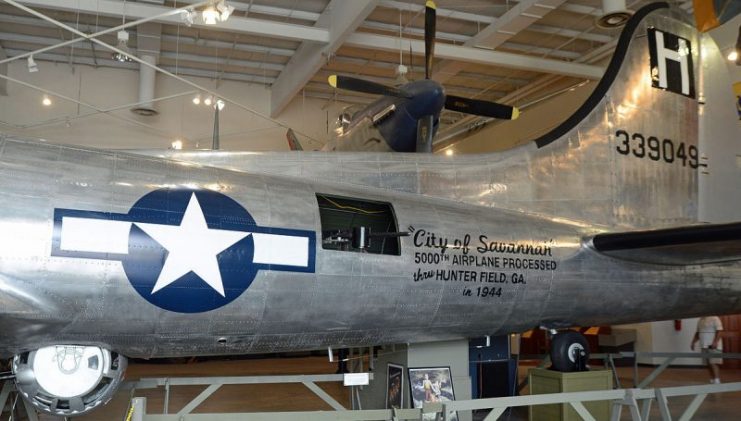
Both men were born in the 1920s and came of age with the onset of WWII. Both served in the Eighth Air Force in England, Joe with the 94th Bomb Group, stationed in Rougham, and Bud with the 95th Bomb Group at Horham.
The two veterans have different stories of their 8th Air Force careers and later life after they overlapped in time during 1944-45 when they flew out of bases that were only several miles apart while stationed in England. Joe was an officer/navigator, Bud was a sergeant/gunner.
Joe had to parachute into a gray wall of clouds to save his life on his 25th mission. Bud came home safely from all of his missions after several very close calls. Both returned from the war and went to college on the GI Bill. Joe graduated in 1947 from the University of Pennsylvania with a degree in Economics. Bud graduated from Rutgers University in 1948 with a degree in Business Administration and Marketing.
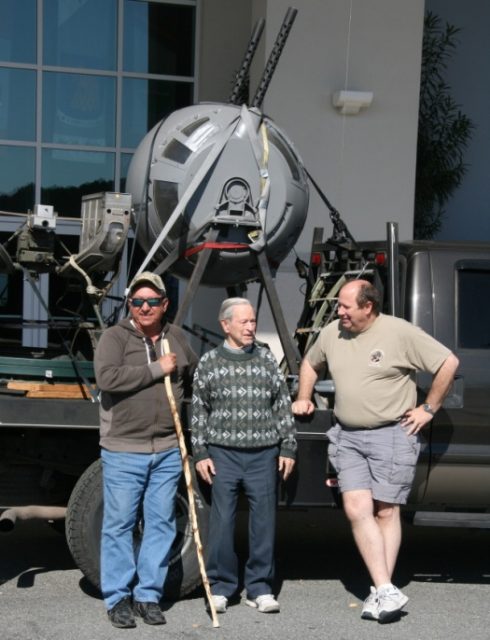
Here are Bud and Joe describing, in their own words, their distinct roles in bringing a major portion of the City of Savannah restoration story to the visitors at the NMMEAF:
Bud Porter: “I have been involved with the National Museum of the Mighty Eighth Air Force since before the building was even built, and I have witnessed some great moments in the museum’s history. One of my favorite memories is the arrival of the B-17 in 2009. When I saw that silver airplane coming down the road to the museum I was so proud to be a member of the organization that was going to restore her. I have a big place in my heart for that wonderful B-17 that has been named the City of Savannah.
Another special moment for me was when the ball turret was purchased for the museum by a generous donor (Joe Glasser). Two volunteers picked the turret up in California and drove it all the way across country. I met them as they arrived at the museum. Later, when I looked at the final restoration of the turret, just before it was going to be installed in the airplane, the interior looked exactly as I remembered it. The idea that the turret will actually operate for the public to see my home in the sky during my combat missions means a great deal to me.

The restoration volunteers and museum visitors often ask me questions about what it was like to fly in a B-17 during the war, and particularly in the ball turret. I enjoy answering their questions about my time in the Eighth Air Force and particularly in that turret. I am grateful for what the volunteers have done in restoring the turret so that I can show visitors my “office” when I was flying missions.
Whenever I walk into the Combat Gallery and look at the City of Savannah, my time in England with the 8th Air Force comes back like it was only yesterday. It is hard to express my feelings for that airplane – I guess you could say that I feel like I am visiting an old friend. It’s very emotional for me.
The B-17 City of Savannah was brought to the Mighty Eighth to honor all of the kids like me who flew over Europe 70 years ago and never came home. I think about them every day, every day! As a survivor I honor them by remembering who they were, and what they did because I know, I was there.” (Letter to the author, June 2016)
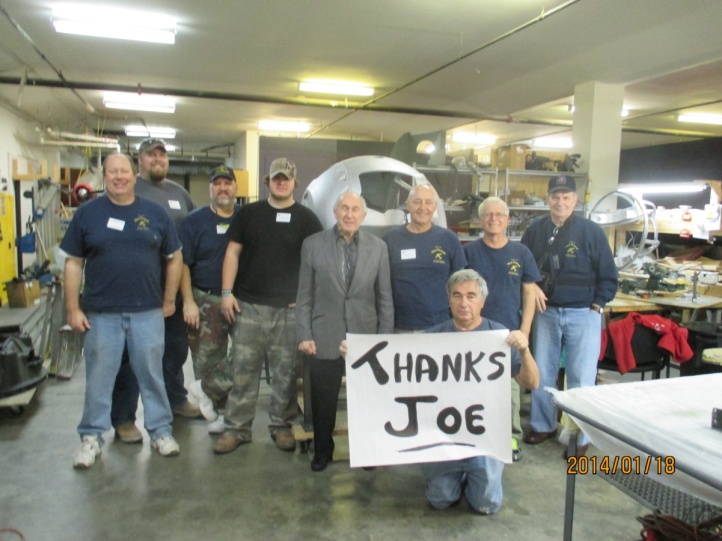
Joe Glasser: “When the war ended in Europe, in May of 1945, my crew and I had just finished 34 of our required 35 missions to complete our combat tour. We had lost both our pilots along the way in a horrific bailout situation where they had both been injured, but thankfully, everyone on our original crew survived the war and was able to resume their lives as private citizens.
I returned to Connecticut and like several million of my fellow veterans I settled into civilian life and utilized the GI Bill to obtain a college education. I chose to remain in the military reserves and was recalled during the Korean War and then remained on flight status until 1970.
I retired at the rank of Lt. Colonel in 1985 with more than 40 years of service. I also participated in the civilian side of government service for many years, serving on the National Labor Relations Board and on multiple federal arbitration boards between 1967 and 2008. Outside of government, I formed my own corporation, Eljen, named for my wife and daughter.
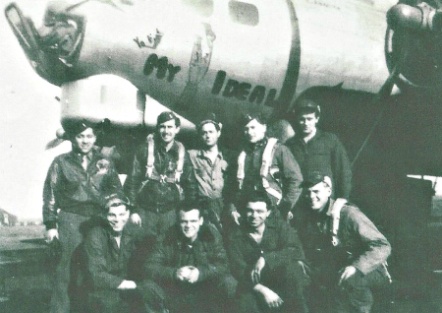
While deeply involved in my several careers I also maintained an emotional connection with my short history as a young warrior. I was a dues-paying member of what was originally called The Eighth Air Force Museum, located in Pooler, Georgia. I would read the various mailings that they sent out with a modicum of interest, glad to maintain a small connection with my WWII colleagues.
Then, in 2009 I started to read about the B-17 that the museum had been gifted by the Smithsonian and I began to show more interest. Finally, in early 2012, I called the museum and asked to speak to whoever was running the B-17 project. That person, it turns out, was a volunteer by the name of Jerry McLaughlin.
“Jerry and I talked for quite a while as he supplied me with details of where the project was at that time and its plans for the future. I asked how I could help and Jerry told me that the City of Savannah did not have a ball turret and that there was a complete B-17 ball turret for sale in California that had been used in the movie Memphis Belle. We discussed the price and logistics of purchasing the turret, and I agreed to fund the purchase while the museum would incur the expenses to have it delivered from California to Georgia.
“Thus began a wonderful relationship between this WWII Eighth Air Force veteran, the volunteers of the City of Savannah project, and the National Museum of the Mighty Eighth Air Force. I was honored to be invited to the 2013 Annual Dinner sponsored by the museum to honor the B-17 volunteers, where I met everyone involved with the project.
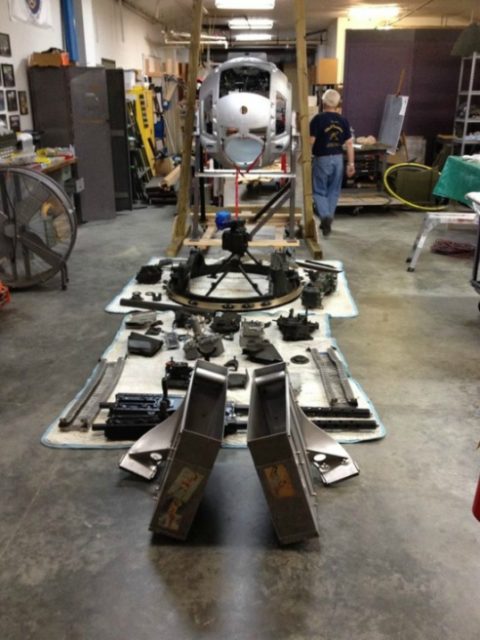
for installation on the City of Savannah.
“Since that time I have kept in touch with both Jerry and the CEO of the museum, Henry Skipper, and made two additional donations to support the restoration of the B-17’s lower cockpit, which had been my crew position in 1944-45. Just this year, I helped sponsor the NMMEAF’s presentation of the National WWII Museum’s traveling exhibition on the subject of American industry’s role in WWII.
“I am truly honored to be able to help the wonderful people at the NMMEAF as they continue to tell the story of my generation and the role we played in the history of our great country.” (Letter to the author, April 2017)
Almost a year after the ball turret arrived at the museum, and after several thousand man-hours of work by the volunteers, the ball turret – now referred to as “Bud’s Office” – was mounted on the City of Savannah while local TV crews, a large group of museum visitors, and almost every restoration volunteer involved with the project witnessed the event.
Bud was, of course, the center of attention – not only for the media and his friends from the various museum groups but also for the visitors who were told that he had actually flown in a similar turret in WWII. Everyone commented on the sparkle in his eye and the pride he showed as he repeatedly stated that it was his honor to represent all the other young men who had gone to war with him in 1945.
Working as a docent and standing next to his “office,” Bud spent the final three years of his life captivating visitors with his first person accounts of his missions as a WWII B-17 ball turret gunner. Thousands of visitors listened, captivated by his magical manner that enabled him to hold the attention of every museum visitor he met, from students to senior citizens.
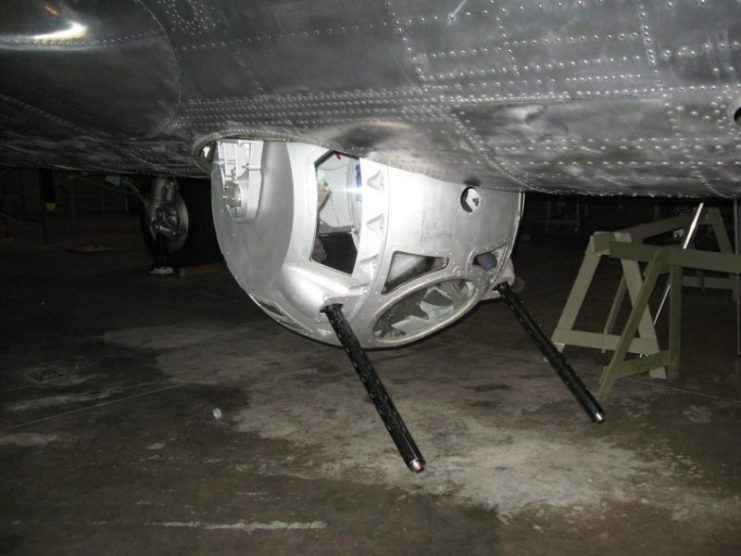
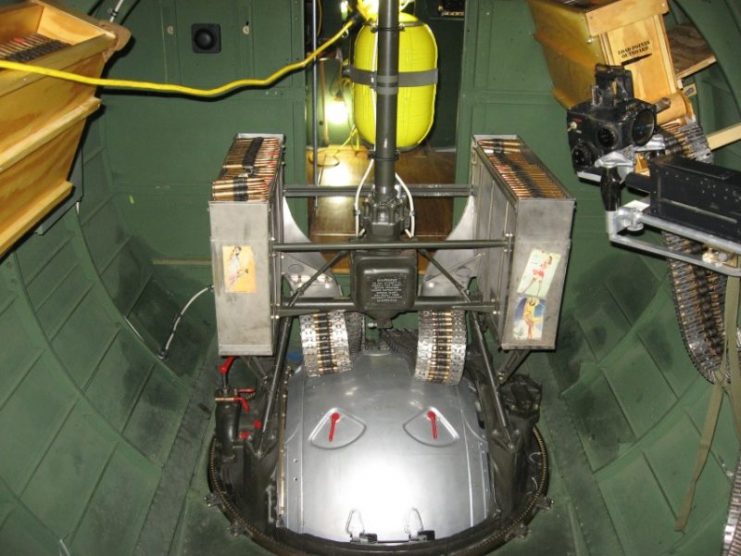
Bud was an icon of the historical mission of the NMMEAF and literally cannot be replaced. He made his last flight on March 22, 2017.
Today, Joe Glasser lives in Connecticut and is still active in business at the age of 93. While Bud’s role in telling the story of his life as a young gunner was personally presented to the public because of his proximity to the museum, it was Joe’s role as a donor that provided Bud with the “office” to present his story. Joe shares Bud’s strong desire to tell the story of the young men who made up the Eighth Air Force ranks during WWII, and it was Joe’s initiative and generosity that made Bud’s storytelling possible.
Joe Glasser and Bud Porter, two Eighth Air Force veterans who never met, yet shared a vision which united them in a singular mission to keep the story of their generation alive.
